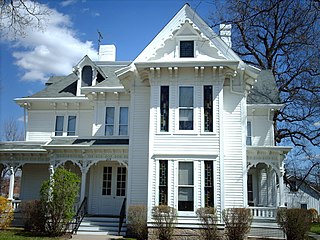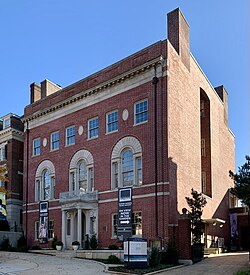
Edith Wilson was the first lady of the United States from 1915 to 1921 and the second wife of President Woodrow Wilson. She married the widower Wilson in December 1915, during his first term as president. Edith Wilson played an influential role in President Wilson's administration following the severe stroke he suffered in October 1919. For the remainder of her husband's presidency, she managed the office of the president, a role she later described as a "stewardship", and determined which communications and matters of state were important enough to bring to the attention of the bedridden president.

The Richard Nixon Birthplace is the birthplace and early childhood home of Richard Nixon, the 37th president of the United States. It is located on the grounds of the Richard Nixon Presidential Library and Museum in Yorba Linda, California, and serves as a historic house museum.

The Woodrow Wilson Presidential Library and Museum is a complex located in Staunton, Virginia. It contains the President's birthplace, known as the Manse, a Museum that explores the life and times of Woodrow Wilson (1856–1924), a 6,800 square feet (630 m2) Research Library, a gift shop, and several other buildings that are not open to the public. Like all United States presidential libraries for administrations prior to that of Herbert Hoover, Wilson's is not part of the Federal National Archives' presidential library system.

James Madison's Montpelier, located in Orange County, Virginia, was the plantation house of the Madison family, including Founding Father and fourth president of the United States James Madison and his wife, Dolley. The 2,650-acre (1,070 ha) property is open seven days a week.

Lyndon B. Johnson National Historical Park is a United States National Historical Park in central Texas about 50 miles (80 km) west of Austin in the Texas Hill Country. The park protects the birthplace, home, ranch, and grave of Lyndon B. Johnson, 36th president of the United States. During Johnson's administration, the LBJ Ranch was known as the Texas White House because the President spent approximately 20% of his time in office there.

The Harry S. Truman National Historic Site preserves the longtime home of Harry S. Truman, the 33rd president of the United States, as well as other properties associated with him in the Kansas City, Missouri metropolitan area. The site is operated by the National Park Service, with its centerpieces being the Truman Home in Independence and the Truman Farm Home in Grandview. It also includes the Noland home of Truman's cousins, and the George and Frank Wallace homes of Bess Truman's brothers. The site was designated a National Historic Site on May 23, 1983.

William Howard Taft National Historic Site is a historic house at 2038 Auburn Avenue in the Mount Auburn Historic District of Cincinnati, Ohio, a mile (1.6 km) north of Downtown. It was the birthplace and childhood home of William Howard Taft, the 27th president and the 10th chief justice of the United States. It is a two-story Greek Revival house built circa 1845.

The presidential memorials in the United States honor presidents of the United States and seek to showcase and perpetuate their legacies.

Westland Mansion was the home of Grover Cleveland, the 22nd and 24th president of the United States, from his retirement in 1897 until his death in 1908. The house is located in the historic district of Princeton, New Jersey, and is a National Historic Landmark also known as the Grover Cleveland Home.

Oatlands Historic House and Gardens is an estate located in Leesburg, Virginia, United States. Oatlands is operated by the National Trust for Historic Preservation and is listed on the National Register of Historic Places as a National Historic Landmark. The Oatlands property is composed of the main mansion and 415 acres of farmland and gardens. The house is judged one of the finest Federal period country estate houses in the nation.

The Hoover House, formally known as the Lou Henry Hoover House or the Lou Henry and Herbert Hoover House, is a historic house located on the campus of Stanford University in Stanford, California, United States. Completed in 1920, it is the former house of Herbert Hoover, 31st president of the United States, and his wife Lou Henry Hoover, who designed it. It is now the official home of the president of Stanford. In addition to its importance as a residence of the Hoovers, the house is a significant early example of the International Style of architecture. It was designated a National Historic Landmark in 1985.

Grant Cottage State Historic Site is an Adirondack mountain cottage on the slope of Mount McGregor in the town of Moreau, New York. Ulysses S. Grant, the 18th President of the United States, died of throat cancer at the cottage on July 23, 1885. The house was maintained as a shrine to U.S. Grant following his death by the Mount McGregor Memorial Association and a series of live-in caretakers. The building became a New York State Historic Site in 1957 and was added to the National Register of Historic Places in 1971. The Historic Site was designated a National Historic Landmark by the National Park Service in 2021.

The Murie Ranch Historic District, also known as the STS Dude Ranch and Stella Woodbury Summer Home is an inholding in Grand Teton National Park near Moose, Wyoming. The district is chiefly significant for its association with the conservationists Olaus Murie, his wife Margaret (Mardy) Murie and scientist Adolph Murie and his wife Louise. Olaus and Adolph Murie were influential in the establishment of an ecological approach to wildlife management, while Mardy Murie was influential because of her huge conservation victories such as passing the Alaska National Interest Lands Conservation Act of 1980 and being awarded with the highest civilian honor, the Presidential Medal of Freedom, for her lifetime works in conservation. Olaus Murie was a prominent early field biologist in the U.S. Biological Survey and subsequent U.S. Fish and Wildlife Service before retiring and becoming the president of the Wilderness Society, He was a prominent advocate for the preservation of wild lands in America.

Prospect House, known also as just Prospect, is a historic house on the Princeton University campus in Princeton, Mercer County, New Jersey, United States. Built in 1851, it is a fine example of the work of architect John Notman who helped popularize Italianate architecture in America. Notable residents include Woodrow Wilson during his tenure as president of the university. The building now serves as a faculty club. It was designated a National Historic Landmark in 1985 for its architecture and historic associations.

Shadow Lawn is a historic building on the campus of Monmouth University in West Long Branch, Monmouth County, New Jersey, United States. Built in 1927 for Hubert T. Parson, president of the F.W. Woolworth Company, it is one of the last large estate houses to be built before the Great Depression. It was designated a National Historic Landmark in 1985 for its architecture.

The Louis Brandeis House is a National Historic Landmark on Judges Way, a private way off Stage Neck Road in Chatham, Massachusetts. It stands on a neck of land near the Oyster Pond River. It received its landmark designation in 1972 as the principal summer residence of Louis Brandeis, an Associate Justice of the United States Supreme Court, who summered here from 1922 until his death in 1941.

The Woodrow Wilson Boyhood Home is a historic house museum at 419 7th Street in Augusta, Georgia. Built in 1859, it was a childhood home of Woodrow Wilson (1856–1924), the 28th president of the United States and proponent of the League of Nations. The house is owned and operated by Historic Augusta, Inc., and was designated a National Historic Landmark on October 6, 2008.

The Landmark Inn State Historic Site is a historic inn in Castroville, Texas, United States. It serves the general public as both a state historic site and a bed & breakfast with eight overnight rooms.

The Woodrow Wilson Family Home is located in Columbia, South Carolina and was one of the childhood homes of the 28th President Woodrow Wilson. He lived in the house from 1871 to 1875.

Blair House, also known as The President's Guest House, is an official residence in Washington, D.C., the capital of the United States. The President's Guest House has been called "the world's most exclusive hotel" because it is primarily used as a state guest house to host visiting dignitaries and other guests of the president. Parts of the historic complex have been used for an official residence since the 1940s.





















